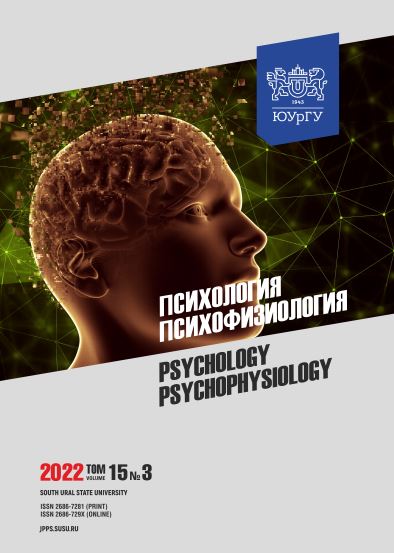Individual profiles of functional asymmetry of the brain among medical students
Abstract
Introduction. The concept of the complementary and fundamental nature of interhemispheric interaction for neurophysiological functions is the basis for identifying types of hemispheric asymmetry and related psychovegetative features. A qualitative assessment of the status and prognosis of university adaptation in adverse conditions requires taking into account the functional organization of the brain. Thus, the profiling of hemispheric asymmetry in medical students is relevant for the prognostic assessment of university adaptation in adverse conditions. Aims. to identify the individual profiles of functional asymmetry of the brain among medical students at the stage of initial adaptation to university, to assess the stability of its signs, to provide its prognostic assessment. Materials and methods. 213 first-year students took part in the study. Hemispheric lateralization was identified at the beginning and end of the semester by means of the NS-Psychotest computer system. The data obtained were processed using Statistica 10.0 and the Wilcoxon–Mann–Whitney test. Results. Five regular phenotypes of functional asymmetry of the brain were identified. Left hemispheric dominance was found in 123 students (59 %). Mixed hemispheric dominance (Types II, III, and IV) was identified in 81 students (37 %). Right hemispheric dominance was found in 9 students (4 %). The so-called pure hemispheric dominance was more characteristic of girls, while the mixed one was typical of boys. Conclusion. Thus, five regular phenotypes of functional asymmetry and their features were identified at the stage of initial adaptation to university. The psychovegetative support and adaptation cost will be different depending on the profile of hemispheric dominance.
Downloads
References
2. Bisiacchi P., Cainelli E. Structural and functional asymmetry of the brain in the early stages of life: a review. Structure and function of the brain. 2022;227(2):479–496. DOI: https://doi.org/ 10.1007/s00429–021–02256–1
3. Sha Z., Shaven D., Carrion-Castillo A. et al. Genetic architecture of structural left–sided asymmetry of the human brain. Nature Human Behaviour. 2021;5(9):1226–1239. DOI: https://doi.org/10.1038/s41562–021–01069–w
4. Agadzhanyan N.A., Makarova I.I. Ethical aspect of adaptive physiology and morbidity of the population. Ekologiya cheloveka = Human ecology. 2014;3:3–13. (in Russ.).
5. Shi G., Li X., Zhu Y. et al. The divided brain: the functional asymmetry of the brain underlying self–interpretation. Neuroimage. 2021;240:118382. DOI: https://doi.org/10.1016/j.neuroimage.2021.118382
6. Poborsky A.N., Yurina M.A., Lopatskaia Zh.N. Features of the functional state of the body of students with different profiles of asymmetry of the cerebral hemispheres under examination stress. Vestnik Surgutskogo gosudarstvennogo universiteta. Meditsina = Vestnik SurGU. Medicina. 2011;9:4–12. (in Russ.).
7. Galuske R.A., Schlote W., Bratzke H. et al. Interhemispheric asymmetries of the modular structure in human temporal cortex. Singer Science. 2020;289(5486):1946–1949. DOI: https://doi.org/10.1126/science.289.5486.1946.
8. Pestryaev V.A., Safina T.V. Hemispheric asymmetry of trophotropic and ergotropic regulation. Asimmetriya = Asymmetry. 2014;8(2):48–58. (in Russ.).
9. Leutin V.P., Nikolaeva E.I. Funktsionalnaya asimmetriya mozga: mify i deistvitelnost [Functional asymmetry of the brain: myths and reality]. St. Petersburg, Rech. 2005:368. (in Russ.).
10. Larkin I.I. Vysshie korkovye funktsii [Higher cortical functions]. Omsk. 2021:117. (in Russ.).
11. Mundorf A., Petersurs J., Ocklenburg S. Asymmetry in the central nervous system: a perspective of clinical neurology. Frontiers in Systems Neuroscience. 2021. DOI: https://doi.org/10.3389/ fnsys.2021.733898
12. Wu X., Kong X., Vatansever D. et al. Dynamic changes in brain lateralization correlate with human cognitive performance. PLoS Biology. 2022;20(3): e3001560. DOI: https://doi.org/10.1371/ journal.pbio.3001560
13. Koen J.D., Srokova S., Rugg M.D. Age-related neural dedifferentiation and cognition. Current Opinion in Behavioral Sciences. 2020;32:7–14. DOI: https://doi.org/10.1016/j.cobeha.2020.01.006
14. Agadzhanyan N.A., Baevskii R.M., Berseneva A.P. Problemy adaptatsii i uchenie o zdorove [Problems of adaptation and the doctrine of health]. Moscow, RUDN. 2006:284. (in Russ.).
15. Antropova L.K., Andronnikova O.O., Kulikov V.Y., Kozlova L.A. Functional asymmetry of the brain and individual psychophysiological features of a person. Meditsinaiobrazovanie v Sibiri = Medicine and education in Siberia. 2019;3. Available at: https://mos.ngmu.ru/archive/index.php?number=36 (accessed 10.01.2022) (in Russ.).
16. Franks C. In search of the biological roots of the typical and atypical asymmetry of the human brain: a comment on “Phenotypes in the functional segregation of the hemispheres? Prospects and problems” Guy Wingerhoets. Physics of Life Reviews. 2019;30:22–24. DOI: https://doi.org/ 10.1016/j.plrev.2019.07.004
17. Hartvigsen G., Bengio U., Bzdok D. How does the specialization of the hemisphere contribute to the cognition that defines a person? Neuron. 2021;109(13):2075–2090. DOI: https://doi.org/ 10.1016/j.neuron.2021.04.024
18. Sander K., Chai X., Barbeau E.B. et al. Brain interhemispheric functional communication predicts the success of learning a new language in adults. Cerebral Cortex. 2022;131. DOI: https://doi.org/10.1093/cercor/bhac131
19. Hirnstein M., Hugdal K., Housman M. Cognitive sex differences and hemispheric asymmetry: a critical review of 40 years of research. Laterality. 2019;24(2):204–252. DOI: 10.1080/ 1357650X.2018.1497044
20. Postema M.С., Carrion-Castillo A., Fischer S.E. et al. The genetics of situs inversus without primary ciliary dyskinesia. Scientific Reports. 2020;10(1):3677. DOI: https://doi.org/ 10.1038/s41598–020–60589–z
21. Novikova E.I. Dynamics of signs of interhemispheric asymmetries in the process of age development. Grani poznaniya = Facets of cognition. 2018;6:70–74. (in Russ.).
22. Kulikov V.Yu., Antropova L.K., Kozlova L.A. Effect of functional brain asymmetry to adopt strategies of individual behavior in stressful situations. Meditsina i obrazovanie v Sibiri = Medicine and education in Siberia. 2010;5. Available at: https://www.elibrary.ru/
download/elibrary_17740497_81307809.pdf (accessed 10.01.2022) (in Russ.).
23. Ignatova Yu.P., Makarova I.I., Zenina O.Yu., Aksenova A.V. Modern aspects of the study of functional hemispheric asymmetry of the brain. Ekologiya cheloveka = Human ecology. 2016;9:30–39. (in Russ.).
24. Revisiting hemispheric asymmetry in mood regulation: implications for rTMS for major depressive disorder / B.C. Gibson, A. Vakhtin, V.P. Clark et al. // Brain Science. 2022;12(1). DOI: https://doi.org/10.3390/ brainsci12010112
25. Leutin V.P., Nikolaeva E.I., Fomina E.V. Asymmetry of the brain and human adaptation. Asimmetriya = Asymmetry. 2007;1:71–73. (in Russ.).
26. Notova S.V., Kiyaeva E.V., Alidzhanova I.E. et al. Psychophysiological and metabolic aspects of adaptation and maladaptation of students. Vestnik Orenburskogo gosudarstvennogo universiteta = Bulletin of the Orenburg State University. 2015;13:63–68. (in Russ.).
References on translit
-Copyright (c) 2022 Psychology. Psychophysiology

This work is licensed under a Creative Commons Attribution-NonCommercial-NoDerivatives 4.0 International License.



